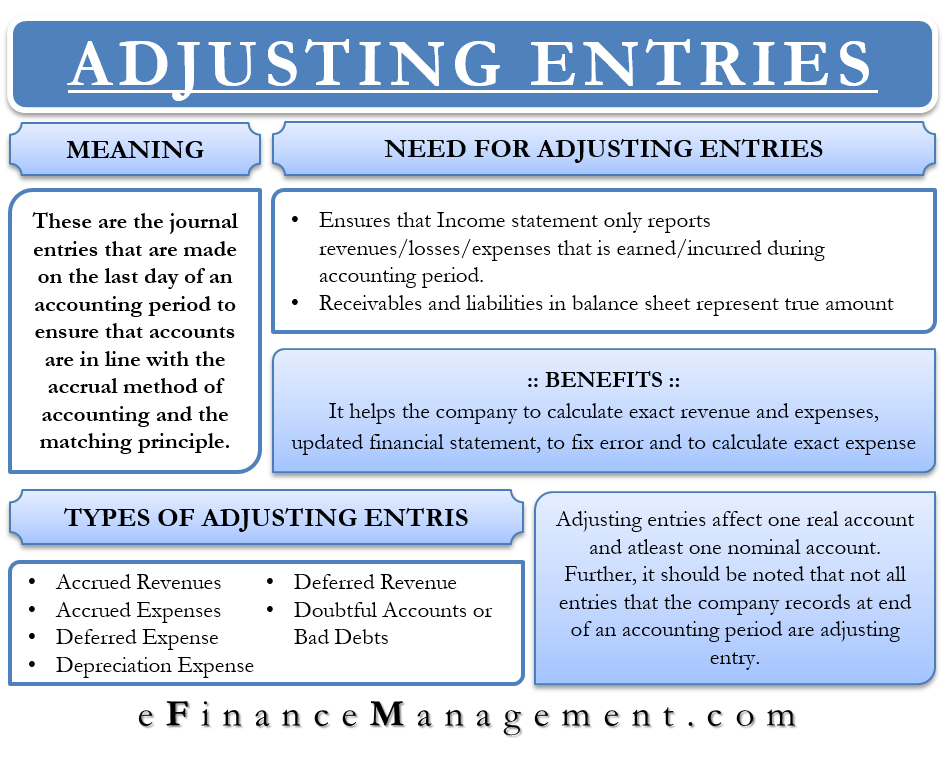
To make an adjusting entry for wages paid to an employee at the end of an accounting period, an adjusting journal entry will debit wages expense and credit wages payable. Adjusting entries, or adjusting journal entries (AJE), are made to update the accounts and bring them to their correct balances. The preparation of adjusting entries is an application of the accrual concept and the matching principle. Adjusting journal entries can affect various accounts on the balance sheet and income statement, including expense accounts, revenue accounts, asset accounts, liability accounts, and receivable accounts. Adjustment entries are important accounting tools that help businesses to accurately record their financial transactions and ensure that their financial statements are accurate.
What is the difference between adjusting entry and closing entry?
Without adjustment entries, the financial statements would not be a reliable source of information for investors, creditors, and other stakeholders. Besides the five basic accounting adjusting entries, it’s important to remember that you can use adjusting entries for any transaction. Prepaid expenses are assets that you pay for and use gradually throughout the accounting period. Office supplies are a good example, as they’re depleted throughout the month, becoming an expense. Essentially, in the month that the expense is used, an adjusting entry needs to be made to debit the expense account and credit the prepaid account.
What is your current financial priority?

When a company purchases a vehicle, the car isn’t immediately expensed because it will be used over many accounting periods. This principle only applies to the accrual basis of accounting, however. If your business uses the cash basis method, there’s no need for adjusting entries. Non-cash expenses – Adjusting journal entries are also used to record paper expenses like depreciation, amortization, and depletion. These expenses are often recorded at the end of period because they are usually calculated on a period basis. This also relates to the matching principle where the assets are used during the year and written off after they are used.
Mistake: Incorrect Accounting Entries
In the next lessons, we will illustrate how to prepare adjusting entries for each type and provide examples as we go. These entries can also involve the use of supplies accounts to record the use of inventory or other supplies. Depreciation is the process of assigning a cost of an asset, such as a building or piece of equipment over the economic or serviceable life of that asset. We at Deskera offer an intuitive, easy-to-use accounting software you can access from any device with an internet connection. This is extremely helpful in keeping track of your receivables and payables, as well as identifying the exact profit and loss of the business at the end of the fiscal year.
The bookkeeper or accountant must ensure that the adjustment is recorded correctly as a debit or credit to the appropriate account, depending on the nature of the adjustment. The revenue recognition principle requires businesses premier online customer ratings and product reviews to recognize revenue when it is earned, regardless of when payment is received. Adjustment entries are necessary to ensure that revenue is recognized in the correct period, even if payment has not been received.
Your Financial Statements At The End Of The Accounting Period May Be Inaccurate
Adjusting journal entries are accounting journal entries that update the accounts at the end of an accounting period. Each entry impacts at least one income statement account (a revenue or expense account) and one balance sheet account (an asset-liability account) but never impacts cash. Recording adjusting journal entries is one of the major steps in the accounting cycle before the books are closed for the period and financial statements are issued. According to the matching principle, revenues and expenses must be matched in the period in which they were incurred. This means that expenses that helped generate revenues should be recorded in the same period as the related revenues. Prepaid expenses or unearned revenues – Prepaid expenses are goods or services that have been paid for by a company but have not been consumed yet.
They must be assigned to the relevant accounting periods and reported on the relevant income statements. Adjusting entries enable you to adjust revenues and expenses to the accounting period within which they occurred. When you record journal transactions normally, it should be done in real-time. This is because, under the accrual basis of accounting, you need to register income/expenses as soon as invoices are raised or bills are received. The adjusting entry, therefore, shows that money has been officially transferred. In most cases, it’s not possible to remain in compliance with accounting standards – such as the International Financial Reporting Standards (IFRS) – without using adjusting entries.
Depreciation is the allocation of the cost of a long-term asset over its useful life. To record depreciation, an adjusting entry is made to decrease the asset account and increase the corresponding depreciation expense account. Prepaid insurance is insurance that has been paid for but not yet used.
- When your business makes an expense that will benefit more than one accounting period, such as paying insurance in advance for the year, this expense is recognized as a prepaid expense.
- These entries are necessary to ensure that financial statements accurately reflect the company’s financial position and performance.
- The depreciation of fixed assets, for example, is an expense which has to be estimated.
- Adjusting entries are necessary to ensure that financial statements accurately reflect a company’s financial position.
Companies that take the time to properly record and adjust their accounts will be better equipped to make informed business decisions and meet their financial obligations. Adjustment entries are an important tool for businesses to ensure that their financial statements are accurate. These entries can impact a business’s cash flow, profitability, stock-based compensation, accounting periods, and fiscal year. Accumulated depreciation is the total amount of depreciation recorded for a long-term asset since it was acquired. To record accumulated depreciation, an adjusting entry is made to increase the accumulated depreciation account and decrease the corresponding asset account. Accounting software can be used to simplify the process of recording adjustment entries.
You’ll need to make an accrued expense adjusting entry to debit the expense account and credit the corresponding payable account. When you make an adjusting entry, you’re making sure the activities of your business are recorded accurately in time. If you don’t make adjusting entries, your books will show you paying for expenses before they’re actually incurred, or collecting unearned revenue before you can actually use the money. The purpose of adjustment entries is to bring the accounts up to date and to ensure that the financial statements accurately reflect the company’s financial position and performance. Income statement accounts that may need to be adjusted include interest expense, insurance expense, depreciation expense, and revenue. The entries are made in accordance with the matching principle to match expenses to the related revenue in the same accounting period.
If the Final Accounts are prepared without considering these items, the trading results (i.e., gross profit and net profit) will be incorrect. In this situation, the accounts thus prepared will not serve any useful purpose. However, in practice, the Trial Balance does not provide true and complete financial information because some transactions must be adjusted to arrive at the true profit. The main objective of maintaining the accounts of a business is to ascertain the net results after a certain period, usually at the end of a trading period. Press Post and watch your fixed assets automatically depreciate and adjust on their own.
